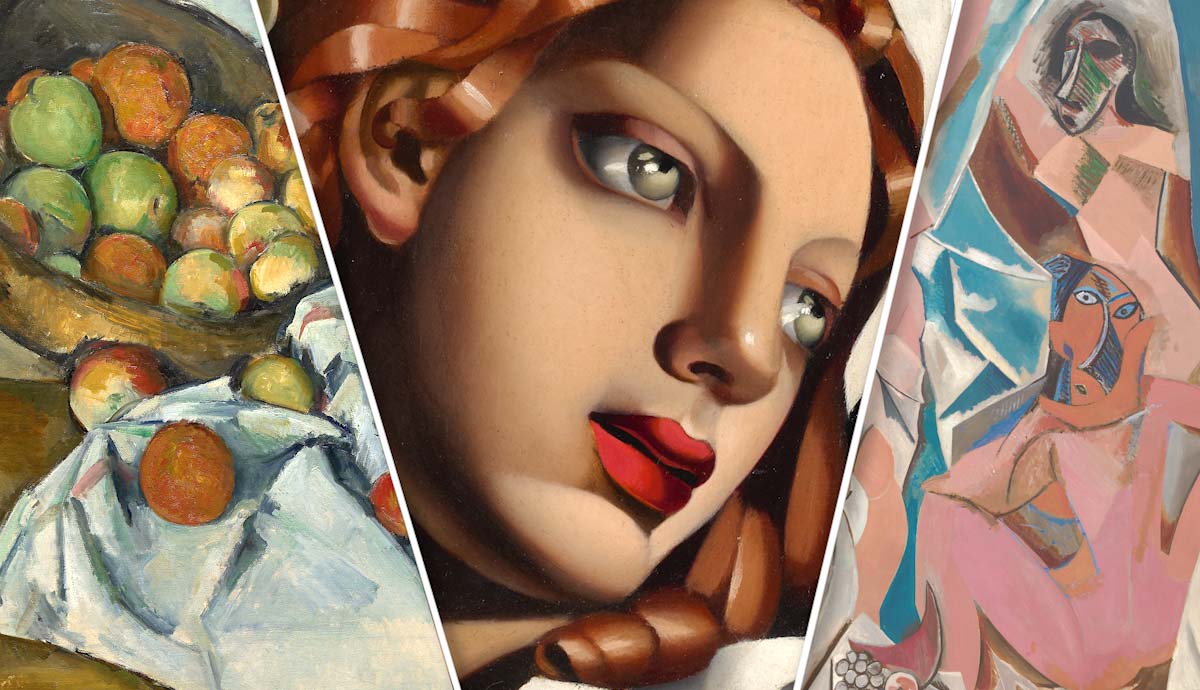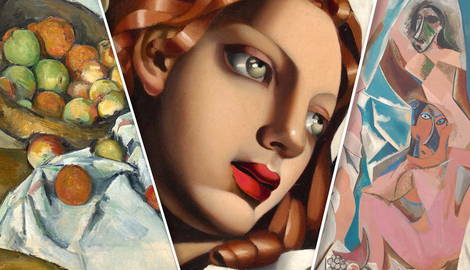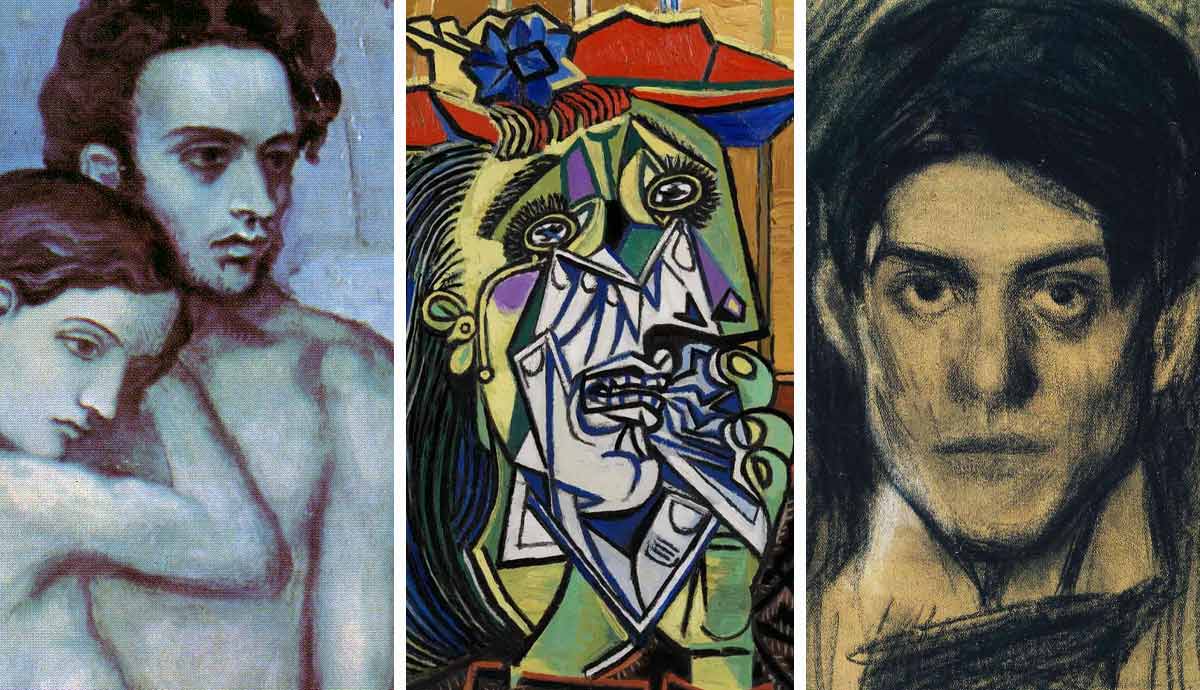
Cubism was one of the most radical art movements of the 20th century. Emerging in Paris, Cubism was both influential and polarizing, leaving no one indifferent. Discover the principles and evolution of the movement through the works of seven famous Cubist artists who shaped the movement.
1. Pablo Picasso (1881-1973)

Pablo Picasso is the undoubted hero of both Cubism and modern art. Moving from genre to genre, from one philosophy to another, Picasso tried to seek inspiration outside of traditional domains, looking to non-Western art and prehistoric artifacts. Picasso’s path toward his new visual language was not simple and required some questionable and sometimes even illegal actions.
In 1907, Picasso and his friend, the famous poet Guillaume Apollinaire, arranged a museum heist. Apollinaire’s acquaintance Joseph Géry Pieret stole two prehistoric Iberian sculptures from the Louvre. The point of the heist was not financial gain but Picasso’s desire to study the sculptures in depth and discover the secret of their unique proportions. However questionable and immoral, this method proved effective, with Picasso soon presenting his groundbreaking Les Demoiselles d’Avignon. The composition of nude female figures using flat planes of color was influenced by African masks and the stolen Iberian busts.
Nonetheless, the crime committed by the artist and his friends caught up with him several years later. In 1911, the Louvre lost its precious Mona Lisa when someone entered the museum disguised as an employee and stole the painting. For months, Picasso and Apollinaire were the prime suspects, until the real culprit revealed himself.
2. Georges Braque (1882-1963)

One of the closest friends of Picasso and Apollinaire, Georges Braque was one of the most important figures in the genesis of Cubism. His works became an important basis for Apollinaire’s writings on theories of Cubist art, which expressed its principles and aims. Braque’s most radical and groundbreaking works refer to the period before his service in World War I. In combat, he was traumatized both mentally and physically, temporarily losing his eyesight. Although he remained a devoted Cubist and even criticized Picasso for leaving the movement behind, his works became more emotional and philosophic, sometimes even carrying an existential undertone.
While discussing the legacy of Cubist art, art historians usually divide it into several stages varying in aesthetic and philosophical principles. The first stage, evident in Braque’s artistic oeuvre, was Analytical Cubism. It received its name from the methodical and prolonged dissection of reality, which turned three-dimensional objects into clusters of flat planes and viewpoints. Concerned with geometry, Analytical Cubism paid minimal attention to color, deliberately limiting the palette to greys and browns.
Braque’s Glass on a Table is a prime example of Analytical Cubism, composed in 1909-1910. The painting features a glass, pears, and a small box on a table, but these elements are fragmented and reassembled in a pure representation of the style, challenging traditional notions of spatial representation.
3. Tamara de Lempicka (1898-1980)

Tamara de Lempicka was the student of two great artists: Andre Lhote, another Cubist, and Maurice Denis, the famous Post-Impressionist. From Denis, she inherited the decorative qualities of art, with canvases covered with ornaments and details. At the same time, Lhote taught her how to turn the aggressive Cubist line into something more fluid and romantic, carrying the spirit of Art Deco.
Tamara de Lempicka turned to art to save her family from financial catastrophe. Lempicka and her husband were Poles forced to flee the Russian Empire as the revolution unfolded. They settled in Paris with barely any savings and connections. Part of Lempicka’s artistic appeal was her carefully fabricated personality of a wealthy libertine socialite. Her public appearances and love affairs were almost as scandalous as her paintings.
However, her proactive social life barely left any room for her family. One of Lempicka’s favorite models was her daughter Kizette, who nonetheless never received any attention for her artistic input. Presenting her portraits to the public, Lempicka claimed that the child was a random model found on the street and not her own daughter.
L’Éclat, composed in 1932, is a lush and sensuous depiction of a bright-eyed young woman whose carefully curled auburn hair, adorned by bunches of green grapes (which perfectly match her eye color) is set against an abstracted black, gray, and white background of suggested drapery. The sitter’s full, parted red lips add an additional eroticism to the composition, while the dramatic light from a mysterious source to the right of the picture plane suggests both the influence of Caravaggio and the golden age of Hollywood.
4. Marie Laurencin (1883-1956)

Marie Laurencin was one of the rare women associated with the Cubist movement. Aggressive masculine aesthetics and strict geometry were rarely associated with feminine art, yet Laurencin was one of the few radicals who went on to break the rules. She studied art alongside Georges Braque and was the only woman included in the 1912 exhibition La Maison Cubiste. Apart from her avant-garde accomplishments, she was a prolific poet, theater set designer, and book illustrator. She illustrated writings by Jean Cocteau and Edgar Allan Poe.
Laurencin’s art was not completely Cubist, yet it widely incorporated its elements, mostly through composition and background details. One of the most famous paintings by Laurencin, titled The Young Girls, looks oddly similar to the groundbreaking works of Picasso, yet appears to be significantly less threatening and more poetic in nature. The Cubist landscape in the background does not overpower the elegant figures. Unlike the intimidating masks of Les Demoiselles d’Avignon, they are peaceful and gracious while still referencing ancient sculptures and non-Western art.
5. Juan Gris (1887-1927)

Spanish-born artist Juan Gris, the superstar of the Cubist movement, was notably different from his colleagues. As a young art student, he studied mechanical drawing, and perhaps the strict geometry and precision later affected his avant-garde experiments. Gris’ artistic aim was not only to shock the audience and challenge traditional painting conventions, but also to make his works aesthetically pleasing. Influenced by his close friend Henri Matisse, he used bold color combinations, putting emotion over rigid rules and barriers. According to the famous art collector Gertrude Stein, Gris was the only artist capable of intimidating Picasso with his talent and boldness.
A significant part of Juan Gris’ artistic oeuvre refers to the sub-genre of Synthetic Cubism, which combined painting with collage. Apart from traditional paint and canvas, artists started to use newspaper clips, wallpaper, and found objects. Gris’s Flowers, painted in 1914, is a prime example of Synthetic Cubism, characterized by its use of collage elements and a focus on simplified, geometric forms. The painting features a still life with flowers, a coffee cup, and a newspaper, all rendered in a style that combines flat planes and fragmented shapes. Gris’s innovative use of collage, incorporating wallpaper and other materials, adds a layer of texture and visual interest to the composition.
Unfortunately, Gris did not have much time to develop his artistic experiments further. In 1927, he passed away from kidney failure, yet he left behind a remarkable and lasting legacy. The long list of artists inspired by the bold experiments of Juan Gris includes Diego Rivera, Salvador Dali, and Andy Warhol.
6. Gino Severini (1883-1966)

Italian artist Gino Severini is best known for his involvement with the Futurist movement, yet after World War I, he moved away from it in favor of creating his own artistic experiments. Initially, the Futurists chose the Cubist style as their weapon of choice against old-timey art and morals. However, they soon realized that despite its scandalous potential, Cubism was rigid, devoid of dynamism, and relied on classical subjects like still-lives and landscapes. To combat this rigidness, they chose to focus on movement and speed, reflecting not objects but the space around them affected by their presence,
Gino Severini spent most of his life in Paris and managed to become friends with important people there despite his limited knowledge of French. He was a frequent guest at parties hosted by Suzanne Valadon; he often socialized with Picasso, Braque, and Gris, and partied with his fellow Italian Amedeo Modigliani. After leaving the Futurist circles, Severini managed to keep the same fluidity and dynamism in his Cubist works.
In 1915, Severini produced Red Cross Train Passing a Village. In this painting of a train moving through the countryside, Severini split the landscape to impart a sense of the momentary, fractured images that characterize our perception of a speeding object. The clash of intensely contrasting colors suggests the noise and power of the train, which the Futurists admired as an emblem of vitality and potency.
In his later years, Gino Severini became a staunch advocate of Neo-Classicism, promoting the return to more traditional styles of painting.
7. Paul Cezanne (1839-1906)

Although Paul Cezanne was not a member of the Cubist circles, as he passed away in 1906, right before the movement revealed itself to the public, he nonetheless became one of the most important precursors of the philosophy of the Cubist artists. Usually categorized as a Post-Impressionist, Cezanne believed that any object or event could be translated into the language of simple geometric forms of squares, circles, and triangles.
Moreover, his still-lives painted in the last decade of the 19th century already represented his objects from several perspectives at once. The painting Basket of Apples shows some fruit from their sides and some from their tops, although they all are seemingly located on the same flat plane of a dining table. Juan Gris once said that Cezanne made a cylinder out of a glass bottle so the next generations of artists could turn cylinders back into bottles.
According to many art experts and legendary artists, Paul Cezanne was the most important person in the genesis of the European avant-garde. His legacy is present even in the works of Abstract Expressionists. Although it was devoid of any figuration, it was Cezanne’s bold ideas that bridged the gap between representational art and pure abstraction.










